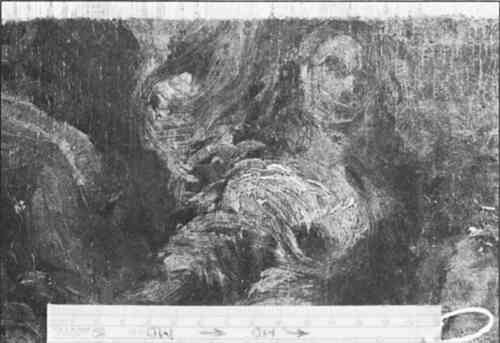DETERIORATION OF SURFACES EXPOSED TO ENVIRONMENTAL CHANGESGUSTAV A. BERGER, & WILLIAM H. RUSSELL
10 PRACTICAL EXAMPLES SUPPORTING THE NEW MODEL OF PAINT DECAYONCE THE rules of surface decay became clear to us, we found overwhelming evidence to support them in paintings we inspected. To keep this article within manageable limits, only some of the most striking examples are given below to prove the importance of a stiff support for the preservation of paintings. In addition to the painting on copper (fig. 15), the Austrian or Czech late Baroque sketch, 56 � 43.5 cm. is an excellent example (fig. 16). Like many early canvas paintings, it was fastened to its strainer with glue rather than nails. The strainer, made of solid lindenwood, could not be keyed out. Because of its expansions and contractions, the canvas within the strainer has slackened and distorted. It was, therefore, decided to remove the painting from its strainer. Regrettably, we did not realize at the time that we had an excellent example for our theory. The 4 cm–wide strip where the painting was firmly glued to the strainer was free of cracks. However, the unattached area in the center was covered by the usual primary and secondary crackle system, typical of a 250-year-old canvas painting. Since the entire painting has the same technique, materials, and history, the excellent preservation of the 4 cm–wide edges can only be attributed to the firm support provided by its attachment to the strainer.
A discarded 17th-century copy of The Spinners by Vel�zquez was extensively tested in our lab (fig. 17)(Berger and Russell, 1987). Our tests determined that this canvas was six times stiffer in the vertical (weft) direction than in the horizontal (warp) direction. The photograph shows that most of the cracks run in the vertical direction. Therefore, the paint cracks in the weaker, more flexible horizontal direction of the canvas.
The stiffness of the canvas provided by constant tension also explains the amazing state of preservation of cyclorama paintings, which originally inspired this research (Berger 1981). The upper parts of these huge canvases are stretched by the weight of 12–15 meters of heavy, painted canvas pulling on them. This continuous tension supplies sufficient stiffness to resist the movements of the paint. It has protected the paint film from cracking and cupping, in spite of the very adverse environmental conditions in which these paintings were kept. In the bottom parts of the cycloramas, where there is no such tension, the paint has the cracks typical of a neglected, century-old painting. Based on the above observations, a new stretcher for canvas paintings was designed to simulate the beneficial effects of constant tension (Berger 1983, 1984). The spring-loaded stretcher is said to have been invented by Wright and Gardner in 1875, and a later one was designed at the Fogg Art Museum and subsequently used by Richard Buck and many others, including one of the authors. Other versions were developed by Rigamonti in Italy, Vidal in France, and others. However, all these designs with diagonal expansions in the corners were structurally unsound (wobbly) and ameliorated only partially the defects of the rigid stretchers, while introducing new problems along the diagonals. The self-adjusting constant tension stretcher (U.S. Patent Serial No. 571,350) follows an entirely new design. It has a rigid, structurally sound body and permits the canvas to expand and contract freely, in both directions, in response to environmental changes. The suspension system of the self-adjusting, constant-tension stretcher was repeatedly tested on the stress tester. Comparing the stress fluctuations of the “shrinking canvas” held on a rigid stretcher (up to 1500%) (fig. 1) with the same canvas suspended by springs (30%) (fig. 18), one can see clearly the benefits of the self-adjusting stretcher. The sample supported by springs is exposed to much more violent fluctuations of the environment, but its tension remains virtually constant. As a result, the paint has sufficient support at all times. In addition, while in figure 1 the tension dropped by 50% after a single exposure to 100% RH, the spring-supported sample shows no drop in tension even after two prolonged exposures to 100% RH. In addition, constant tension reduces cupping, since the stress differentials due to shrinkage and expansion of the canvas are eliminated. The painting Easter Monday, by Willem de Kooning (Metropolitan Museum of Art, New York), cracked and delaminated and was removed from display due to its precarious state. Following mounting on the self-adjusting, constant-tension stretcher, the condition of the painting has improved, and it is now on permanent exhibition. It even graces the cover of at least two of the museum's publications. We have received similar reports regarding paintings by Sam Gilliam and Helen Frankenthaler at the High Museum of Art in Atlanta and a rather large Morris Louis at the Philadelphia Museum of Art.
∗ See General Remarks at bottom of page 48 However, the constant-tension stretcher can only succeed if the canvas retains sufficient strength to support the tension exerted on it by the springs. This tension is usually smaller than the peak tensions imparted to the painting by its natural contractions. If the canvas is too weak to be stretched sufficiently to effectively support a brittle or uneven paint film, then lining is indicated. Not only does lining impart stiffness to the canvas, but by its bulk it also protects the painting from fluctuations of the environment. Figure 19 shows a painting by Jean L�on G�r�me that was patched or “locally lined” in the past, obviously before cracking set in. The stiffness of the patches has protected the patched areas, which are free of cracks, while the rest of the painting is severely cracked. Had the patch covered the entire painting, it would have remained free of cracks. |


